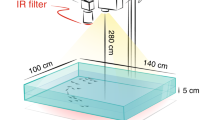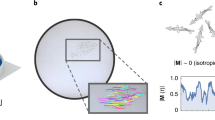Abstract
AGGREGATION in planktonic organisms is often observed, both in the sea and in fresh water, and several explanations have been put forward to account for it. Uneven light intensity can often lead to aggregation; but other reasons must be put forward to account for swarms under uniform illumination. Some authors consider the animal's own behaviour to be responsible for swarming; thus social behaviour has been invoked in Cladocera1, chemosensitivity in Hemimysis2 and visual orientation to explain Mysid shoaling3. Other authors regard physical processes as being largely or entirely responsible, such as wind-generated turbulence4, retention in convection cells5 or in a weak convergence, aided by photopositive swimming6.
Similar content being viewed by others
References
Colebrook, J. M., J. Anim. Ecol., 29, 241 (1960).
Bainbridge, R., J. Mar. Biol. Assoc., U.K., 32, 385 (1953).
Steven, D. M., Nature, 192, 280 (1961).
Bary, B. M., N.Z. J. Sci. Tech. Bull., 34, 393 (1953).
Stommel, H., J. Mar. Res., 12, 148 (1949).
Bainbridge, R., Biol. Rev., 32, 91 (1957).
Crisp, D. J., and Southward, A. J., Nature, 178, 1076 (1956).
Author information
Authors and Affiliations
Rights and permissions
About this article
Cite this article
CRISP, D. Swarming of Planktonic Organisms. Nature 193, 597–598 (1962). https://doi.org/10.1038/193597a0
Issue Date:
DOI: https://doi.org/10.1038/193597a0
- Springer Nature Limited
This article is cited by
-
Biophoton emission fromDaphnia magna: A possible factor in the self-regulation of swarming
Experientia (1991)
-
Horizontal patchiness in zooplankton populations in two Ontario kettle lakes
Hydrobiologia (1983)
-
Diurnal surface concentrations of zooplankton in Lake Taupo, New Zealand
Hydrobiologia (1965)





